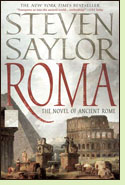Roma
by Steven Saylor
Reviewed by David Maclaine

Steven Saylor's Roma is a convenient, easy-reading route for getting up to speed on Rome's development from a modest settlement of traders to the capital of Augustus' empire. Its eleven chapters span a full millennium, so each stopover is a bit like those quick trips to world capitals that accommodate the traveler who wants to sample the famous landmarks in one city and move on to the next. But you should come away from it with a solid sense of the city itself and the personalities who shaped its growth.
Roma is constructed along the lines made popular by James Michener, who made a very good living with novels that focused on a particular locale, tracing its history across the centuries by way of separate stories, sometimes interlinked by family. Saylor repeats the pattern, but with a bit less density and detail than the model; Roma's chapters are at most slightly long short stories. There are helpful little maps at the beginning of each chapter in Roma which show the gradual growth of the city and the construction of key landmarks. Saylor's plotting and characterization are perfunctory - you can hardly expect great literature from what is, in essence, a serving of Michener Lite - but the chapters go down smoothly without much aftertaste, and the final effect is pleasing enough, with a relaxed time spent, and a fair foundation laid for richer books to come.
Saylor chooses to set his episodes almost exclusively inside the Roman city limits and has invented his own legendary family to bind together the assortment of legends and historical happenings he has extracted from the chief compendiums of Roman tradition and history; one might easily have called it “Tales from Livy.” But Roma succeeds in its modest goal; it's a fine introduction for those who haven't heard the stories and are interested in finding out more. (2007, 555 pages) More about Roma at Powell's Books, Amazon.comRoma appears on the list of The 50 Best Historical Novels for a Survey of Ancient Roman History
Other time-sweep novels:
Empire by Steven Saylor (2010), sequel to Roma. See review or more info at Powell's Books
London by Edward Rutherfurd (1996), about the people living in what is now London from the time of Julius Caesar's first invasion of Britain into modern times. More info
The Source by James A. Michener (1965), about the land that is now Israel from prehistoric to modern times. More info
Nonfiction about ancient Rome:
The Rise of Rome by Anthony Everitt (2012). More info
Ancient Rome: The Great Men, Army and Wars by Robert F. Pennell (2011). More info
Ancient Rome: The Rise and Fall of an Empire by Simon Baker (2006). More info
Online:
Ancient Rome History at Ancient-Rome.com
Back to Novels of Ancient History
Back to Directory of Book Reviews